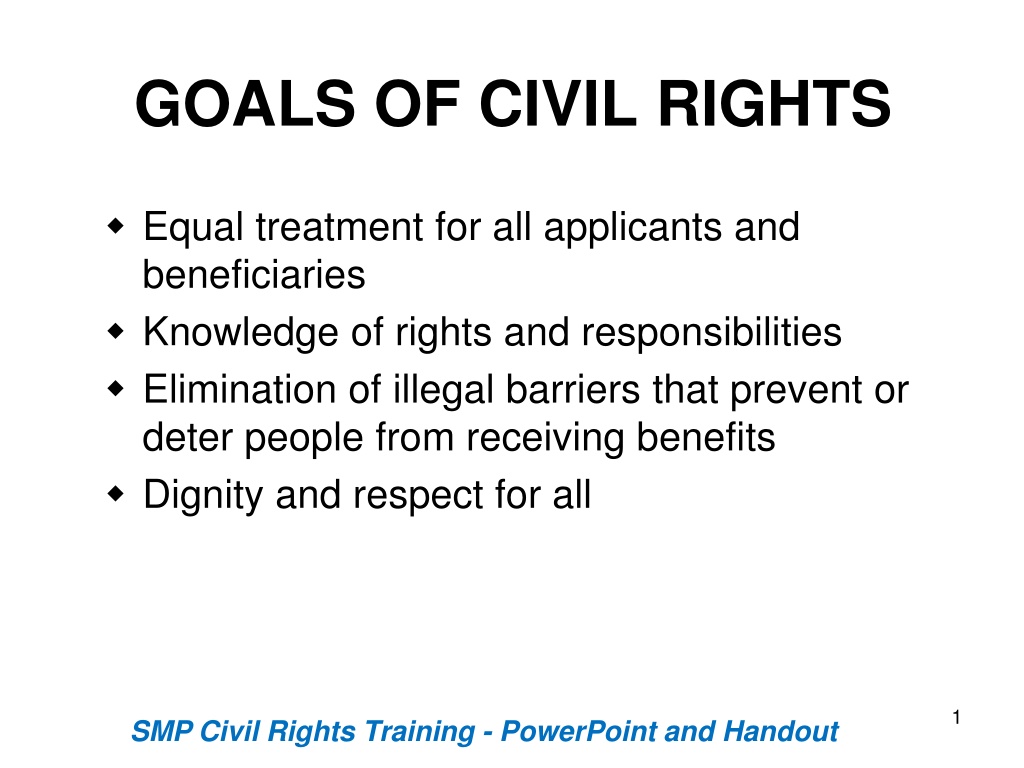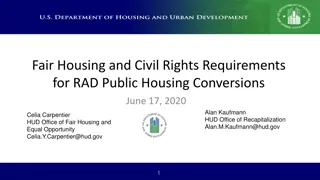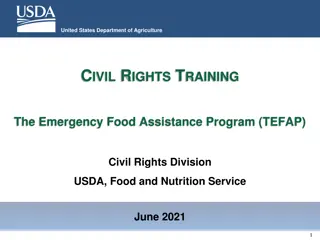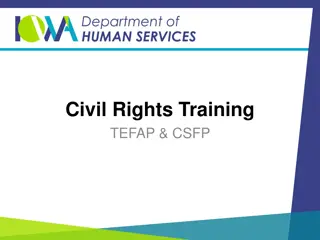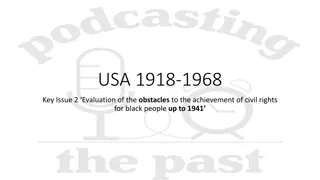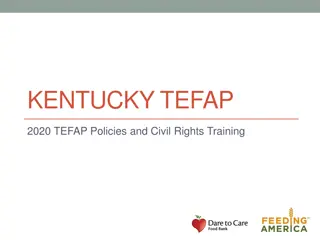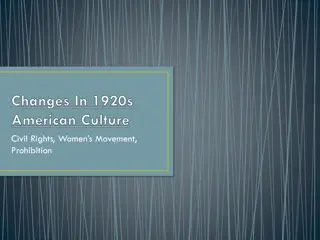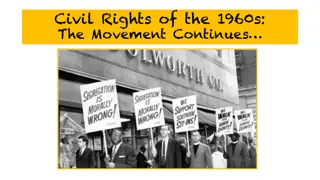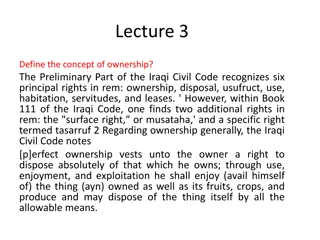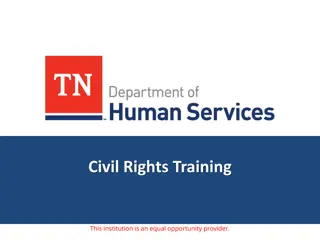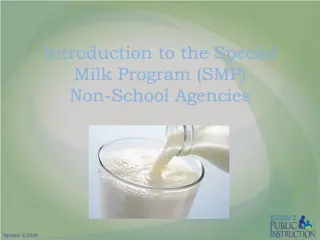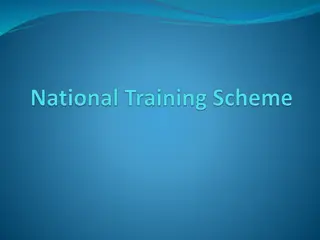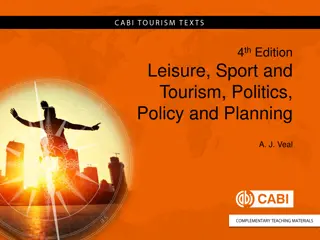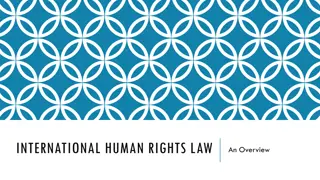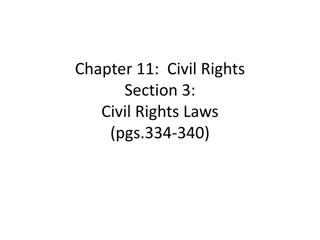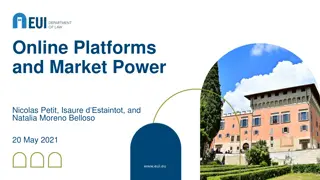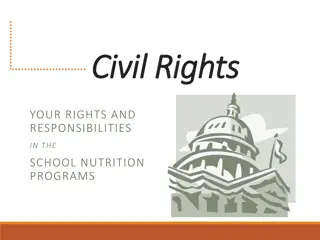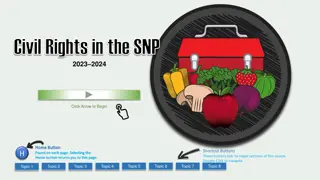Civil Rights Training Overview for SMP Participants
This civil rights training presentation covers the goals of civil rights, discrimination, protected classes, examples of discrimination, components of civil rights compliance, and the importance of equal access for all participants in the SMP program. It emphasizes equal treatment, knowledge of rights, eliminating barriers, and dignity for all individuals. The training also highlights the public notification requirements and outlines key aspects of civil rights procedures and services.
Download Presentation

Please find below an Image/Link to download the presentation.
The content on the website is provided AS IS for your information and personal use only. It may not be sold, licensed, or shared on other websites without obtaining consent from the author.If you encounter any issues during the download, it is possible that the publisher has removed the file from their server.
You are allowed to download the files provided on this website for personal or commercial use, subject to the condition that they are used lawfully. All files are the property of their respective owners.
The content on the website is provided AS IS for your information and personal use only. It may not be sold, licensed, or shared on other websites without obtaining consent from the author.
E N D
Presentation Transcript
GOALS OF CIVIL RIGHTS Equal treatment for all applicants and beneficiaries Knowledge of rights and responsibilities Elimination of illegal barriers that prevent or deter people from receiving benefits Dignity and respect for all 1 SMP Civil Rights Training - PowerPoint and Handout
What is Discrimination? The act of distinguishing one person or group of persons from other, either intentionally, by neglect, or by the effect of actions or lack of actions based on their protected classes. What Is a Protected Class? Any person or group of people who have characteristics for which discrimination is prohibited based on a law, regulation, or executive order. 2
Discrimination = Four Ds an individual or group is: Denied benefits or services that others receive Delayed receiving benefits or services that others receive TreatedDifferentlythan others to their disadvantage Given Disparate treatment something which does not seem discriminatory, but has a discriminatory impact in practice 3
Examples of Discrimination Refuse a participant s enrollment based on disability Failure to provide reasonable accommodations to disabled individuals Serving meals at a time, place, or manner that is discriminatory Selectively distributing applications and income forms Failure to provide the same eligibility criteria to all participants Failure to provide foreign language materials regarding SMP 4
Components of Civil Rights Compliance Public Notification System Outreach and Education Data Collection Reasonable Accommodations Language Assistance Civil Rights Complaint Procedures Technical Assistance and Training Customer Service Conflict Resolution 5
Equal Access All participants who attend must be provided equal access to the benefits of the SMP. To withhold the program from any eligible age group is age discrimination. 6
Public Notification Must include information on: Eligibility Benefits & Services (i.e. assistance with milk purchases) Program availability Applicant rights and responsibilities Procedures for filing a complaint Non-discrimination policies Any programmatic changes (i.e. changing location of a meal site)
Methods of Public Notification Public Release Issued by State Agency Inform the general public that your agency sponsors the SMP and that milk is provided at no separate charge. Post And Justice for All Poster (required) Includes the USDA s required nondiscrimination statement and lists the USDA contact information for filing a complaint of discrimination. Other methods of public notification (optional): Bulletins Letters/Leaflets/Brochures Internet/Computer-based Applications
Public Notification System New Media Release Annually submit to local news media outlet (i.e. newspaper) Keep a copy of file stating where and when submitted (e.g., CC of email, signed certified mail card, affidavit from person receiving)
And Justice for All Poster All agencies participating in Child Nutrition Programs must display the USDA s non-discrimination poster in a prominent area where participants and potential participants have access Examples: cafeteria/food service area, office, centrally located bulletin board Must be posted at every site Must be 11 x 17 format DPI provides posters to centers free of charge. 10 Complete this order form to order additional posters, if needed.
Outreach and Education You want to reach as many potential participants as possible. You want to ensure program access. You need to pay attention to under- represented groups. Include the required nondiscrimination statement on all appropriate FNS and agency publications, web sites, posters, and informational materials. When using graphics, reflect diversity and inclusion. 11
Outreach and Education Cont. Includes non-discrimination statement on all materials that mention or imply SMP and/or USDA programs (including websites) 12
Required Non-Discrimination Statement Language Guidance Memorandum 8 Non-Discrimination Statement 12/15 Revision In accordance with Federal civil rights law and U.S. Department of Agriculture (USDA) civil rights regulations and policies, the USDA, its Agencies, offices, and employees, and institutions participating in or administering USDA programs are prohibited from discriminating based on race, color, national origin, sex, disability, age, or reprisal or retaliation for prior civil rights activity in any program or activity conducted or funded by USDA. Persons with disabilities who require alternative means of communication for program information (e.g. Braille, large print, audiotape, American Sign Language, etc.), should contact the Agency (State or local) where they applied for benefits. Individuals who are deaf, hard of hearing or have speech disabilities may contact USDA through the Federal Relay Service at (800) 877-8339. Additionally, program information may be made available in languages other than English. Continue to next slide for the required complaint filing procedure that goes with this non-discrimination statement. 13
Required Non-Discrimination Statement Language (Cont d) Guidance Memorandum 8 Complaint Filing Procedure 12/15 Revision To file a program complaint of discrimination, complete the USDA Program Discrimination Complaint Form, (AD-3027) found online at: https://www.usda.gov/oascr/how-to-file-a-program-discrimination- complaint, and at any USDA office, or write a letter addressed to USDA and provide in the letter all of the information requested in the form. To request a copy of the complaint form, call (866) 632-9992. Submit your completed form or letter to USDA by: (1) Mail: U.S. Department of Agriculture Office of the Assistant Secretary for Civil Rights 1400 Independence Avenue, SW Washington, D.C. 20250-9410; (2) Fax: (202) 690-7442; or (3) Email: program.intake@usda.gov This institution is an equal opportunity provider. This complaint filing procedure must be included with the USDA non-discrimination statement on previous slide. 14
Required Non-Discrimination Statement Language If the material or document is too small to permit the full statement (previous 2 slides) to be included, the material MUST, at a minimum, include: 12/15 Revision: This institution is an equal opportunity provider. Copy to Paste document available under Resources on website: https://dpi.wi.gov/community-nutrition/ns-smp/resources 15
Collecting and Recording Participation Data Ethnic/Racial data is used to determine how effectively your program is reaching potentially eligible participants and where outreach may be needed. Establish a system to collect ethnic and racial data on an annual basis Program applicants may not be required to furnish ethnicity and race You may inform the household, however, that collection of this information is strictly for statistical reporting and has no influence on eligibility determination for the program. Data collectors may not second guess, change, or challenge a self-declaration of ethnicity/race made by a participant unless such declarations are blatantly false 16
Data Collecting and Reporting Collect ethnic data first, then racial data 1. Ethnicity categories: Hispanic or Latino Non-Hispanic or Non-Latino 2. Racial categories (instructions should specify mark one or more ) American Indian or Alaskan Native Asian Black or African American Native Hawaiian or other Pacific Islander White 17
Obtain ethnic/racial data through Voluntary self-identification or self-reporting USDA issued guidance that visual observation and identification is no longer an allowable practice in obtaining race and ethnicity from SMP participants Household Size-Income Statement (HSIS): The HSIS form completed by each household annually has a section for the household to identify their ethnic and racial data (households are not required to complete this) Use other documentation your agency collects that includes identification of participant ethnic/racial data (i.e., program-specific enrollment form) 18
Ethnic and Racial Data Form Data may be: Annually compiled and documented on this sample Race and Ethnicity Data Form Collected and maintained within a database for annually compiling into a printed report Form available on website 19 https://dpi.wi.gov/community-nutrition/ns-smp/resources
Data Management Collection systems must ensure that data collected/retained are: Collected and retained by each program site Kept secure and confidential Submitted, if requested, to FNS Regional or Headquarters Offices Kept on file for 3 years plus the current program year Identify all sources of information used 20
Conflict Resolution The USDA recommends using an Alternative Dispute Resolution (ADR) program ADR Definition: use of a neutral third party (usually a person acting as a facilitator) to resolve informally a complaint of discrimination through use of various techniques such as fact finding, mediation, peer panels, facilitation, ombudsman support, or conciliation. For more information, visit: Federal Sector Alternative Dispute Resolution | U.S. Equal Employment Opportunity Commission (eeoc.gov) 21
Reasonable Accommodations for Persons with Disabilities Providing Milk Substitutions A disability is defined as any physical or mental impairment substantially limiting one or more major life activities , including digestion. This includes food allergies and intolerances. Programs are required to reasonably accommodate participants whose disabilities restrict their diets by providing substitutions or modifications for their meals, when supported by a proper medical statement The medical statement must: (1) Be from a licensed healthcare professional authorized to write medical prescriptions under Wisconsin law These are: Licensed Physicians; Physician Assistants; and Advanced Practice Nurse Prescribers (APNP) (2) Include a description of impairment (reason for request) and how to accommodate the impairment (e.g., food(s) to be avoided and recommended substitution(s)) 22
Language Assistance Limited English Proficiency (LEP) Definition: Individuals who do not speak English as their primary language and have limited ability to read, speak, write, or understand English. Recipients of Federal financial assistance have a responsibility to take reasonable steps to ensure meaningful access to their programs and activities by persons with LEP. 23
Limited English Proficiency (LEP) Participants should not be used as interpreters. Volunteers may be used, but make sure they understand interpreter ethics particularly confidentiality! Example: Staff with Spanish language skills could assist a household in completing an application but would need to be trained on the importance of keeping all information received from the household confidential 24
Limited English Proficiency (LEP) See www.lep.gov for more information and resources 25
A shortage of resources does not eliminate the translation requirement Suggestions: Share resources to save money Use interpreter from another area Train bilingual staff to be interpreters Contact grassroots organizations to discuss translation or assistance from within the community Language line phone services may be available for a subscription fee through your local telephone service provider 26
Right to File a Complaint Any person who believes he or she or someone he/she knows has been discriminated against based on Federal protected classes (i.e. National origin, race, etc.) has a right to file a complaint within 180 days of the alleged discriminatory action. Complainants should complete the USDA Program Discrimination Complaint Form (AD-3027) found online at: https://www.usda.gov/oascr/how-to-file-a-program- discrimination-complaint Complainants may contact either of the following offices to register a complaint: USDA- Office of the Assistant Secretary for Civil Rights: Refer to slide 14 for the address, fax number, and email address. Wisconsin DPI: Director, Community Nutrition Programs, 125 South Webster Street, P.O. Box 7841, Madison, WI 53707-7841, (608) 267-9129 27
Handling Civil Rights Complaints Complaints can be written or verbal Anonymous complaints should be handled as any other complaint All verbal or written complaints must be forwarded to the WI DPI or USDA s Office of the Assistant Secretary for Civil Rights within three days of receiving a complaint Sponsors must give complainants a Civil Rights Complaint Form to complete (slide 27 has web link) Document all potential complaints in a Civil Rights Complaint Log Have a central location where the Civil Rights Complaint Forms and Civil Rights Complaint Log will be kept 28
The following information should be included in a Civil Rights Complaint Name, address, phone number of complainant, if provided (not required) Specific name and location of entity delivering the benefit or service The nature of the incident, action, or method of administration that led the complainant to feel discriminated against 29
The following information should be included in a Civil Rights Complaint (Continued) The basis on which the complainant feels discrimination exists (race, color, national origin, sex, age, or disability) The names, titles, and business addresses of persons who may have knowledge of the discriminatory action The date(s) during which the alleged discriminatory actions occurred, or if continuing, the duration of such actions 30
Civil Rights Training for Agency Staff All staff who work with the SMP must receive training on all aspects of civil rights compliance annually Topics:-What is Discrimination? -Collecting/recording racial/ethnic data -Where to display posters -What is a Civil Rights complaint -How to handle a Civil Rights complaint Retain training records of the people who received civil rights training 31
Customer Service All participants must be allowed equal opportunities to participate in Child Nutrition programs regardless of race, color, national origin, sex, age, or disability. All participants must be treated in the same manner (i.e., seating arrangements, serving lines, services and facilities, assignment of eating periods, methods of selection for application approval processes). 32
Understanding Differences: Respectful Language Put the person first Example: USE person with a disability , NOT disabled person Use culturally sensitive language Example: USE Asian , NOT Oriental Use inclusive/respectful terms Example: USE chair , NOT chairman The Side Road Business Communication: http://www.sideroad.com/Business_Communication/politically- correct-language.html 33
Ask yourself each time you interact with participants How would I want to be addressed? Am I treating this person in the same manner I treat others? Have I informed this person exactly what information I need to make a determination on the application? Have I given this person the opportunity to clarify all relevant factors or inconsistencies and ask questions? Have I provided this person with needed information to make necessary decisions? 34
Civil Rights Must Do List Provide the SMP in a nondiscriminatory manner Must offer milk to all children at the institution and provide milk substitutions to participants with disabilities Prominently display the And Justice for All poster Non-discrimination statement & complaint filing procedure must be on all printed materials available to the public which mention USDA and/or SMP, including websites Annually complete the Ethnic and Racial Data Form Annually submit the News Media Release to a local news media outlet 35
Civil Rights Must Do List Provide informational materials in the appropriate translation concerning the availability and nutritional benefits of the SMP Train staff annually on Civil Rights and complete a training form Develop & fully implement your Civil Rights Complaint Procedure Make available to all staff: Civil Rights complaint forms, Civil Rights Log and Civil Rights complaint procedure Refer all Civil Rights complaints to DPI or USDA 36 SMP Civil Rights Training - PowerPoint and Handout
